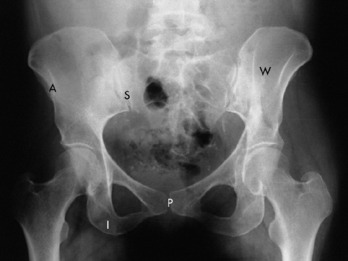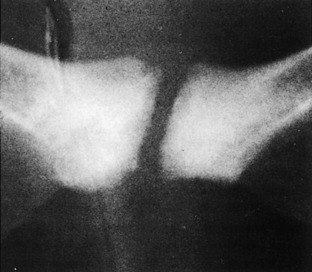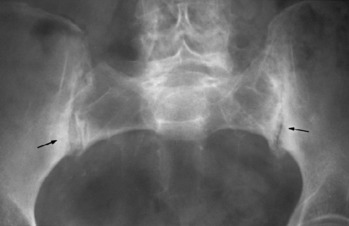Chapter 9 The Pelvis and Sacrum
Anatomy
The bony pelvis is formed by the innominate bones, the sacrum, and the coccyx. Each hip (innominate) bone is composed of three elements: the ischium, the ilium, and the pubis. These three components meet at the acetabulum and are united by the triradiate cartilage until the age of 16 years, when fusion takes place. The sacrum is composed of five vertebrae, and the coccyx usually consists of four. The coccyx and sacrum are situated more posteriorly in women than in men and thus are more exposed to trauma. Very little motion occurs at the sacroiliac (SI) and interpubic joints because of strong ligamentous structures at these areas. Some motion occurs at the sacrococcygeal joint, but little is present between coccygeal segments.
Roentgenographic Anatomy
The pelvis can be well visualized by a routine anteroposterior roentgenogram (Fig. 9-1). In addition, the sacrum and coccyx may be studied by lateral views and anteroposterior views angled 15 degrees cephalad and caudad.
Osteitis Pubis
CLINICAL FEATURES
The onset is gradual, with symptoms developing a few days after the traumatic event. Pain and tenderness over the symphysis pubis are usually present. Coughing may aggravate the pain, which radiates along the adductor and rectus abdominis muscles. Stretching these muscles may reproduce the pain. Symptoms may be unilateral or bilateral. Radiation to the groin, scrotum, or perineal area is common. Examination reveals local tenderness over the symphysis pubis and adjacent soft tissue. Passive abduction of the hips and active adduction of the hips against resistance are painful.
Roentgenograms of the pelvis taken early in the disease course may be normal. Later, variable amounts of spotty demineralization, widening of the symphysis pubis, and sclerosis may be noted (Fig. 9-2). Bone scanning is often positive. Magnetic resonance imaging (MRI) is also valuable. Reossification occurs over several months.
Disorders of the Sacroiliac Joint
OSTEITIS CONDENSANS ILII
This is a lesion of unknown etiology in which bilateral sclerosis of a fairly large area of ilium adjacent to the SI joint occurs (Fig. 9-3). It is most common in multiparous women. Its importance lies in distinguishing it from ankylosing spondylitis (Marie–Strümpell disease). Ankylosing spondylitis is usually associated with an increase in the sedimentation rate and roentgenographic involvement on both sides of the SI joint. Ankylosing spondylitis also occurs primarily in men and is associated with pain. However, there is disagreement as to whether osteitis condensans ilii is ever a painful condition, and it is usually considered to be an incidental radiographic finding. It may be associated with similar lesions in the pubic bones near the symphysis pubis like those seen in osteitis pubis.
SACROILITIS
Bilateral sacroilitis occurs in conjunction with a group of diseases called seronegative spondyloarthropathies (see Chapter 8). The SI joints are involved early in the course of these diseases. The HLA-B27 antigen is usually present in these disorders, which often involve the spinal joints as well.
DEGENERATIVE JOINT DISEASE
Symptomatic involvement of these joints by osteoarthritis is unusual. Even when findings are present roentgenographically, symptoms may be minimal or absent completely (Fig. 9-4). Treatment is symptomatic in these rare cases; surgery is almost never recommended, partly because of the difficulty in the diagnosis. Therapeutic steroid injections may be tried but usually require the inconvenience of fluoroscopic guidance.











